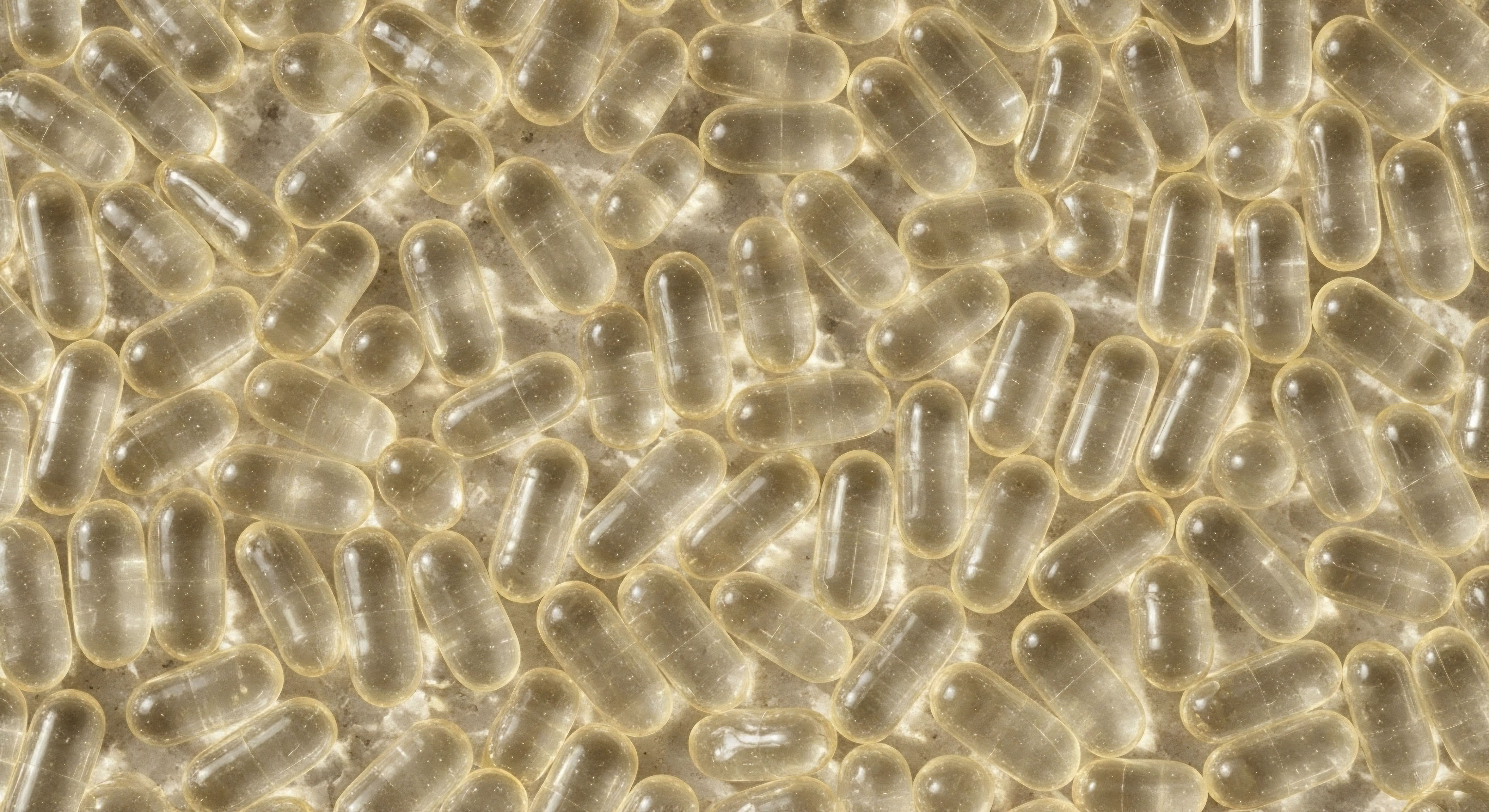

Fundamentals
The sensation of feeling out of sync with your own body can be deeply unsettling. Perhaps you have noticed a subtle yet persistent shift in your energy levels, a diminished capacity for focus, or a change in your physical resilience that simply does not align with your expectations.
Many individuals experience these quiet alterations, often dismissing them as inevitable aspects of aging or the pressures of modern life. Yet, these experiences frequently signal deeper physiological adjustments, particularly within the intricate messaging network of your endocrine system. Understanding these internal communications, especially the long-term patterns of hormonal activity, becomes a cornerstone for reclaiming vitality and maintaining optimal function.
Your body operates through a sophisticated series of internal communications, with hormones serving as the primary messengers. These chemical signals, produced by various glands, travel through your bloodstream to influence nearly every cell and organ. They orchestrate fundamental processes, from metabolism and mood regulation to reproductive health and sleep cycles.
When these messengers are out of balance, even slightly, the systemic impact can be far-reaching, manifesting as the very symptoms that prompt a search for answers. Recognizing the subtle cues your body provides is the initial step toward a more informed approach to wellness.
Hormones act as the body’s essential internal messengers, influencing a vast array of physiological processes and overall well-being.

Understanding Hormonal Equilibrium
Maintaining a state of hormonal equilibrium is not a static condition; rather, it represents a dynamic balance, constantly adapting to internal and external stimuli. This delicate interplay involves feedback loops, where the production of one hormone can influence the release or suppression of another.
For instance, the hypothalamic-pituitary-gonadal (HPG) axis exemplifies such a system, regulating reproductive hormones in both men and women. The hypothalamus signals the pituitary gland, which in turn directs the gonads (testes in men, ovaries in women) to produce sex hormones. This intricate chain of command ensures appropriate hormonal levels are maintained for various bodily functions.
When considering long-term hormonal health, it becomes clear that isolated measurements offer only a snapshot. A comprehensive understanding requires observing trends and patterns over time, much like tracking weather patterns to predict climate. This approach allows for the identification of subtle shifts that might otherwise go unnoticed, providing an opportunity for proactive intervention rather than reactive treatment. The goal is to support the body’s innate capacity for balance, allowing for sustained well-being.

Initial Assessments and Baselines
The journey toward hormonal optimization begins with a thorough initial assessment. This process involves more than just a single blood test; it encompasses a detailed review of your personal health history, a comprehensive symptom evaluation, and a series of targeted laboratory analyses.
These initial data points establish your unique physiological baseline, against which future measurements can be compared. This baseline is not merely a number; it represents your body’s current functional state, providing a personalized reference point for any subsequent interventions.
Typical initial laboratory evaluations often include a broad panel of hormonal markers, reflecting the interconnectedness of the endocrine system. For men, this might involve assessing total testosterone, free testosterone, estradiol, luteinizing hormone (LH), and follicle-stimulating hormone (FSH). For women, assessments might include estradiol, progesterone, testosterone, LH, FSH, and thyroid hormones. These initial readings provide a foundational understanding of your current hormonal landscape, guiding the development of a personalized wellness strategy.

Why Baseline Data Matters
Establishing a robust baseline is paramount for several reasons. It allows clinicians to identify existing deficiencies or imbalances before any therapeutic protocols are initiated. This initial data also serves as a critical reference point for evaluating the effectiveness of any subsequent interventions. Without a clear starting line, it becomes challenging to accurately assess progress or make precise adjustments to a personalized regimen. The initial assessment sets the stage for a data-driven approach to hormonal health.


Intermediate
Once a comprehensive baseline has been established, the focus shifts to implementing and meticulously monitoring personalized wellness protocols. These protocols are not one-size-fits-all solutions; they are carefully calibrated strategies designed to address individual physiological needs and health objectives. The precision of these interventions, whether involving hormonal optimization or peptide therapy, demands a systematic approach to long-term monitoring. This ongoing evaluation ensures both efficacy and safety, allowing for dynamic adjustments as your body responds and adapts.

Clinical Protocols for Hormonal Optimization
Targeted hormonal optimization protocols aim to restore physiological levels of specific hormones, alleviating symptoms and supporting overall function. The selection of agents and their administration routes are tailored to the individual, reflecting a deep understanding of endocrine physiology. Long-term monitoring for these protocols involves regular laboratory assessments and ongoing symptom review, ensuring the regimen remains aligned with your body’s evolving requirements.

Testosterone Replacement Therapy for Men
For men experiencing symptoms associated with diminished testosterone levels, often referred to as andropause or hypogonadism, Testosterone Replacement Therapy (TRT) can be a transformative intervention. A standard protocol frequently involves weekly intramuscular injections of Testosterone Cypionate, typically at a concentration of 200mg/ml. This method provides a steady release of testosterone, helping to restore circulating levels to a healthy range.
To maintain the body’s natural testosterone production and preserve fertility, clinicians often integrate Gonadorelin into the regimen. This peptide is administered via subcutaneous injections, usually twice weekly, stimulating the pituitary gland to release LH and FSH. These gonadotropins, in turn, signal the testes to continue their endogenous hormone synthesis.
Another important consideration is the potential conversion of testosterone to estrogen. To mitigate this, an aromatase inhibitor like Anastrozole may be prescribed as an oral tablet, typically twice weekly, to manage estrogen levels and reduce potential side effects such as gynecomastia. In some cases, Enclomiphene may be included to specifically support LH and FSH levels, further promoting testicular function.
Long-term TRT for men often combines testosterone injections with agents like Gonadorelin and Anastrozole to maintain balance and mitigate side effects.
Monitoring for men on TRT involves regular blood tests to assess:
- Total Testosterone ∞ To ensure levels are within the therapeutic range.
- Free Testosterone ∞ Providing insight into the biologically active portion of the hormone.
- Estradiol (E2) ∞ To monitor estrogen conversion and guide Anastrozole dosing.
- Luteinizing Hormone (LH) and Follicle-Stimulating Hormone (FSH) ∞ To assess pituitary function and the effectiveness of Gonadorelin.
- Red Blood Cell Count (Hematocrit) ∞ To monitor for potential increases in red blood cell production.
- Prostate-Specific Antigen (PSA) ∞ For prostate health screening.

Testosterone Replacement Therapy for Women
Women can also experience symptoms related to suboptimal testosterone levels, particularly during peri-menopause and post-menopause, which can manifest as irregular cycles, mood fluctuations, hot flashes, or diminished libido. For these individuals, targeted testosterone optimization can offer significant relief. Protocols often involve lower doses of Testosterone Cypionate, typically 10 ∞ 20 units (0.1 ∞ 0.2ml) administered weekly via subcutaneous injection.
The inclusion of Progesterone is often based on menopausal status, playing a vital role in balancing estrogen and supporting uterine health in pre- and peri-menopausal women. For some, pellet therapy, which involves the subcutaneous insertion of long-acting testosterone pellets, offers a convenient alternative. Anastrozole may be considered when appropriate, particularly if there is a clinical indication for managing estrogen levels.
Monitoring for women on testosterone optimization protocols includes:
- Total Testosterone and Free Testosterone ∞ To ensure appropriate dosing.
- Estradiol and Progesterone ∞ To assess overall hormonal balance, especially in relation to the menstrual cycle or menopausal status.
- Sex Hormone Binding Globulin (SHBG) ∞ To understand hormone availability.

Post-TRT or Fertility-Stimulating Protocols for Men
For men who have discontinued TRT or are actively trying to conceive, specific protocols are implemented to restore natural testicular function and support fertility. These regimens typically include a combination of agents designed to stimulate endogenous hormone production. Gonadorelin is often utilized to encourage pituitary release of LH and FSH.
Tamoxifen and Clomid, both selective estrogen receptor modulators (SERMs), are employed to block estrogen’s negative feedback on the hypothalamus and pituitary, thereby increasing LH and FSH secretion and stimulating testicular testosterone production. Anastrozole may be optionally included if estrogen management is indicated during this phase.

Growth Hormone Peptide Therapy
Beyond traditional hormone replacement, targeted peptide therapies offer another avenue for optimizing physiological function, particularly for active adults and athletes seeking improvements in anti-aging markers, muscle accretion, fat reduction, and sleep quality. These peptides work by stimulating the body’s natural production of growth hormone, rather than directly introducing exogenous growth hormone.
Key peptides in this category include:
- Sermorelin ∞ A growth hormone-releasing hormone (GHRH) analog that stimulates the pituitary to release growth hormone.
- Ipamorelin / CJC-1295 ∞ A combination often used to provide a sustained, pulsatile release of growth hormone. Ipamorelin is a growth hormone secretagogue, while CJC-1295 is a GHRH analog.
- Tesamorelin ∞ Another GHRH analog, often used for specific metabolic benefits.
- Hexarelin ∞ A potent growth hormone secretagogue.
- MK-677 (Ibutamoren) ∞ An oral growth hormone secretagogue that stimulates growth hormone release.
Monitoring for peptide therapy involves assessing clinical outcomes such as body composition changes, sleep quality, and recovery, alongside specific laboratory markers like Insulin-like Growth Factor 1 (IGF-1), which serves as a proxy for growth hormone activity.

Other Targeted Peptides
The therapeutic landscape of peptides extends to other specific applications:
- PT-141 (Bremelanotide) ∞ This peptide acts on melanocortin receptors in the brain to address sexual health concerns, particularly desire and arousal.
- Pentadeca Arginate (PDA) ∞ This peptide is recognized for its role in tissue repair, accelerating healing processes, and modulating inflammatory responses.
Long-term monitoring for these specialized peptides focuses on the specific clinical outcomes they are intended to address, alongside general health markers.

Long-Term Monitoring Strategies
The effectiveness of any personalized wellness protocol hinges on consistent and intelligent long-term monitoring. This process is iterative, involving regular clinical assessments and laboratory evaluations. The frequency of these assessments is individualized, often starting more frequently (e.g. every 3-6 months) and then extending to annual or semi-annual checks once stability is achieved.
A structured approach to monitoring ensures that any necessary adjustments to dosages or protocols can be made promptly, maintaining optimal physiological balance and preventing potential side effects. This ongoing dialogue between your body’s responses and the clinical strategy is what truly defines personalized wellness.
The following table outlines typical monitoring parameters for various protocols:
| Protocol | Key Hormones/Markers to Monitor | Typical Monitoring Frequency (Initial) |
|---|---|---|
| Testosterone Replacement (Men) | Total Testosterone, Free Testosterone, Estradiol, LH, FSH, Hematocrit, PSA | Every 3-6 months |
| Testosterone Optimization (Women) | Total Testosterone, Free Testosterone, Estradiol, Progesterone, SHBG | Every 3-6 months |
| Post-TRT / Fertility (Men) | Total Testosterone, Free Testosterone, LH, FSH, Estradiol | Every 3-6 months |
| Growth Hormone Peptide Therapy | IGF-1, Body Composition, Sleep Quality, Recovery Markers | Every 6-12 months |
| General Metabolic Health | Fasting Glucose, HbA1c, Lipid Panel, Inflammatory Markers (e.g. hs-CRP) | Annually |


Academic
A deep exploration of long-term hormone monitoring transcends simple measurement; it requires a sophisticated understanding of the endocrine system as an interconnected, adaptive network. The clinical guidelines for sustained hormonal oversight are rooted in the principles of systems biology, recognizing that no single hormone operates in isolation. Instead, each biochemical signal participates in a complex symphony of feedback loops, metabolic pathways, and cellular interactions that collectively dictate physiological function and overall well-being.

The Interplay of Biological Axes and Metabolic Pathways
The human endocrine system is characterized by several critical axes, each a hierarchical chain of command involving the hypothalamus, pituitary gland, and various peripheral endocrine organs. The hypothalamic-pituitary-adrenal (HPA) axis, for instance, governs the stress response, while the hypothalamic-pituitary-thyroid (HPT) axis regulates metabolism.
The HPG axis, as previously mentioned, controls reproductive function. A disruption in one axis can cascade, influencing the others through intricate cross-talk mechanisms. For example, chronic activation of the HPA axis due to persistent stress can suppress the HPG axis, leading to diminished sex hormone production. This systemic view underscores why a holistic monitoring approach is not merely beneficial but essential.
Beyond direct hormonal interactions, the endocrine system is deeply intertwined with metabolic pathways. Hormones like insulin, glucagon, leptin, and adiponectin play central roles in glucose homeostasis, lipid metabolism, and energy balance. Dysregulation in these metabolic hormones can lead to conditions such as insulin resistance, metabolic syndrome, and increased adiposity, which in turn can negatively impact sex hormone production and activity.
For instance, elevated insulin levels can reduce sex hormone-binding globulin (SHBG), increasing free testosterone in women, potentially contributing to conditions like polycystic ovary syndrome (PCOS). Conversely, low testosterone in men is often associated with increased insulin resistance and higher rates of metabolic syndrome.
Hormonal balance is intrinsically linked to metabolic health, with disruptions in one system often influencing the other.

Neurotransmitter Function and Hormonal Influence
The endocrine system also exerts a profound influence on neurotransmitter function and, consequently, on mood, cognition, and behavior. Steroid hormones, including estrogens, androgens, and progesterone, can cross the blood-brain barrier and interact with neuronal receptors, modulating neurotransmitter synthesis, release, and reuptake.
For example, estrogen influences serotonin and dopamine pathways, explaining its role in mood regulation and cognitive function in women. Testosterone similarly affects dopamine and GABA systems, impacting motivation, drive, and anxiety levels in men. Long-term monitoring, therefore, extends beyond peripheral hormone levels to consider the subjective experience of cognitive clarity, emotional stability, and sleep architecture, recognizing these as reflections of neuro-endocrine harmony.

Advanced Biomarkers in Long-Term Monitoring
While standard hormone panels provide foundational data, advanced biomarkers offer deeper insights into cellular function, inflammation, and metabolic health, which are all inextricably linked to hormonal status. These markers can serve as early indicators of systemic stress or imbalance, allowing for proactive adjustments to personalized protocols.
Consider the following advanced markers:
- High-Sensitivity C-Reactive Protein (hs-CRP) ∞ A marker of systemic inflammation. Chronic low-grade inflammation can disrupt endocrine signaling and contribute to hormonal resistance.
- Homocysteine ∞ An amino acid whose elevated levels are associated with increased cardiovascular risk and can indicate deficiencies in B vitamins, which are crucial for methylation pathways involved in hormone metabolism.
- Fasting Insulin and HOMA-IR (Homeostatic Model Assessment for Insulin Resistance) ∞ These provide a more precise assessment of insulin sensitivity than fasting glucose alone, revealing underlying metabolic dysfunction that can impact hormonal balance.
- Adiponectin and Leptin ∞ Adipokines (hormones produced by fat cells) that regulate metabolism and appetite. Imbalances can signal adipose tissue dysfunction, which directly influences sex hormone production and sensitivity.
- Advanced Lipid Subfractions ∞ Beyond standard cholesterol panels, these provide a detailed picture of lipoprotein particle size and number, offering a more accurate assessment of cardiovascular risk, which can be influenced by hormonal status.
The integration of these advanced biomarkers into long-term monitoring protocols allows for a more granular understanding of an individual’s physiological state, enabling truly personalized and preventative strategies.

The Role of Genetic and Epigenetic Factors
The clinical guidelines for long-term hormone monitoring are increasingly incorporating insights from genetics and epigenetics. While genetic predispositions can influence an individual’s hormonal profile and response to therapy, epigenetic modifications ∞ changes in gene expression without altering the underlying DNA sequence ∞ are dynamic and influenced by lifestyle, nutrition, and environmental factors. These epigenetic changes can impact hormone receptor sensitivity, enzyme activity involved in hormone synthesis and metabolism, and overall endocrine resilience.
For example, polymorphisms in genes encoding aromatase (CYP19A1) can influence the rate of testosterone-to-estrogen conversion, necessitating individualized Anastrozole dosing in TRT protocols. Similarly, variations in androgen receptor sensitivity can affect how effectively tissues respond to circulating testosterone. While not routinely part of every monitoring panel, an awareness of these underlying genetic and epigenetic influences informs a more sophisticated, long-term clinical strategy, allowing for anticipatory adjustments and a deeper understanding of individual variability in response to hormonal interventions.
The table below illustrates the interconnectedness of various systems and their relevance to long-term monitoring:
| System/Axis | Key Hormones/Neurotransmitters | Interconnected Impact |
|---|---|---|
| HPG Axis | Testosterone, Estrogen, Progesterone, LH, FSH | Reproductive health, bone density, muscle mass, mood, libido |
| HPA Axis | Cortisol, DHEA | Stress response, immune function, energy levels, sleep quality |
| HPT Axis | Thyroid Hormones (T3, T4, TSH) | Metabolic rate, energy production, body temperature, cognitive function |
| Metabolic Pathways | Insulin, Glucagon, Leptin, Adiponectin | Glucose regulation, fat storage, appetite control, inflammation |
| Neurotransmitter Systems | Serotonin, Dopamine, GABA | Mood, cognition, motivation, anxiety, sleep |
Long-term hormone monitoring, viewed through this academic lens, becomes a continuous process of physiological recalibration. It moves beyond simply correcting deficiencies to optimizing the entire endocrine-metabolic-neurotransmitter network, supporting sustained health and vitality throughout the lifespan. This rigorous, systems-based approach ensures that interventions are not only effective in the short term but also contribute to long-term physiological resilience.

References
- Mooradian, A. D. Morley, J. E. & Korenman, S. G. (1987). Biological actions of androgens. Endocrine Reviews, 8(1), 1-28.
- Bhasin, S. et al. (2010). Testosterone therapy in men with androgen deficiency syndromes ∞ An Endocrine Society clinical practice guideline. Journal of Clinical Endocrinology & Metabolism, 95(6), 2536-2559.
- Davis, S. R. et al. (2015). Global consensus position statement on the use of testosterone therapy for women. Journal of Clinical Endocrinology & Metabolism, 100(12), 4633-4642.
- Vance, M. L. et al. (2016). Growth hormone-releasing hormone (GHRH) and its analogues ∞ A review. Growth Hormone & IGF Research, 26, 1-9.
- Guyton, A. C. & Hall, J. E. (2015). Textbook of Medical Physiology (13th ed.). Elsevier.
- Boron, W. F. & Boulpaep, E. L. (2017). Medical Physiology (3rd ed.). Elsevier.
- Katz, D. L. & Meller, S. (2014). Can we say what diet is best for health? Annual Review of Public Health, 35, 83-103.
- Shufelt, C. L. et al. (2010). Hormone therapy and cardiovascular disease ∞ The current state of evidence. Current Opinion in Cardiology, 25(4), 374-381.
- Traish, A. M. et al. (2009). The dark side of testosterone deficiency ∞ II. Type 2 diabetes and insulin resistance. Journal of Andrology, 30(1), 23-32.
- Sowers, M. R. et al. (2006). Testosterone and estradiol in the early and late stages of the menopausal transition. Journal of Clinical Endocrinology & Metabolism, 91(10), 3858-3864.

Reflection
Having explored the intricate landscape of hormonal health and the detailed considerations for long-term monitoring, perhaps you find yourself contemplating your own physiological narrative. This knowledge is not merely academic; it serves as a powerful lens through which to view your personal health journey.
Consider how the subtle shifts you have experienced might align with the complex biological systems discussed. The path to reclaiming vitality is a deeply personal one, requiring both a scientific understanding of your body’s internal workings and a willingness to engage proactively with your well-being. This information provides a framework, a starting point for a conversation with a qualified clinician who can help translate these broad guidelines into a protocol uniquely suited to your individual needs and aspirations.



